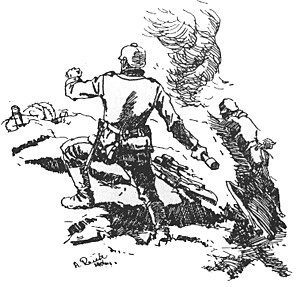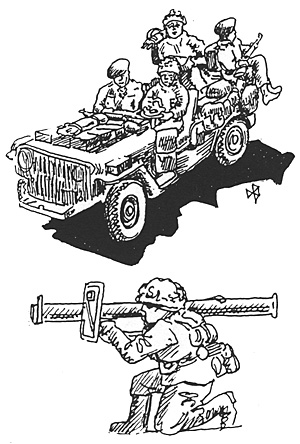
Unlike most wargamers I guess, my solo wargame activity is driven not so much by isolation as by time, or rather the lack of it. As a husband, and the father of two whirling dervishes of 6 and 9, with a full time job that itself seems to be five times busier than it was just 5 years ago, there’s precious little spare time left!
When I get home from work, by the time the children are in bed the last thing I have energy for is to either set up a game for a fellow gamer, or go to travel for a game – much as I’d like to, the spirit is willing but it always seems much easier to collapse exhausted with a beer! As a result my gaming, and the kind of gaming I do, is driven by the time that I do have available to play – lunchtimes and brief slots of time as and when I can get them.
Since lunchtime in the office is notoriously short of eight foot by six foot wargame tables stacked to the gills with gorgeously painted ranks of miniatures, the time is ideal for the type of wargaming that isn’t time/resource dependant and for me that means campaigns. I’ve spent many happy lunchtimes writing up campaign diaries, tussling over the next critical move, and working out or adapting solo rules & techniques!
Some time ago I discovered on the web a piece of software called Berthier that has helped with my campaigning significantly. Berthier (named after Napoleon’s chief of staff) is a campaign aid written by an Australian guy called Tony de Lyall. What it does is help you to manage most, if not all, aspects of a wargame campaign using your PC to do the hard work. It’s also freeware, which means you can’t argue with the price! It is this software, and the possibilities that it holds, that form the subject of this article.
If you have read Featherstone’s “Solo Wargames” you will probably remember that he had one chapter on what he called the ‘matchbox system.’ Berthier recreates this on a grand scale, allowing you to have a virtual matchbox chest consisting of hundreds of matchboxes – in fact at maximum size (99 rows by 99 columns) Berthier will give you almost ten thousand “matchboxes”, but in addition Berthier also allows you to define:
- 1. Terrain types which can be applied to each “matchbox” or grid square, squares can also be defined as towns, depots, etc.
2. Movement speeds and reconnaissance ranges for up 18 different units per side – these can either be the usual foot/horse/artillery or more irregular groupings e.g. all arms formations.
In Berthier, movement is alternate with each side moving all its units in its movement phase by issuing orders to units. Units have the ability to ‘scout’ nearby squares and will advise when they have identified troops of the opposing side. When opposing units enter the same square Berthier indicates that contact has been made, and this can then be either gamed out on the wargames table or within Berthier as it has it own combat resolution function.
As a result of the “I go, you go” move sequence, play by email is easy – each side can password protect it’s ‘part’ of the campaign, and at the end of your turn you simply mail the game files to your opponent so they can do their move..
There are a host of other Berthier features (supply/logistics, transport, messages and couriers, random events, etc.) which I won’t go into here, but the following outline some of the uses I’ve put the system to.
First off the system can be used at either strategic or tactical level. There is no doubt that it is intended as primarily a strategic level campaign aid, and in the horse and foot period, and I have used it in this mode a number of times. One of these campaigns was fought with the Berthier author, Tony de Lyall, and is featured on the Berthier web site.
However, because of its flexibility, I have also used it as a solo assistant with conspicuous success. You can use the usual solo campaign tricks to define the opposing force, where it is, and what triggers it, but there is no doubt that on a large map, especially if it is relatively featureless, with a lot of units on each side, it is difficult to remember where you just moved the other side!
Another one of the features that is also a boon for soloing is that fact that Berthier determines the ‘best’ route to the destination, rather than the gamer, based on terrain between the unit and where you’re telling it to go. What this means is that you can set the enemy's destination(s), but you will have no clear idea which way they will get there – an excellent way of introducing fog of war into a solo campaign.
 In addition I have found the following help:
In addition I have found the following help:
- 1. Define campaign units that contain various types of sub units – kampfgruppe, or army corps depending on your scale, and choose how they are made up by random...
2. Add in a number of dummy units
3. Assign all the campaign units randomly around the map, in towns and other strategic positions – the units are only revealed when scouted, and can only be activated once units are contacted/scouted – at which time the courier rules come into play!
While not my area of interest Berthier will also work well for naval campaigns – the campaign units can be defined as various types of ships; the terrain types mostly water, scouting would work far better than on land as water is relatively featureless so bigger recon ranges can be used...
- 1. There is a facility within Berthier to make a unit type invisible to scouting – ideal for submarines, and opens up vistas of North Atlantic convoy games.
2. Set the recon range for aircraft carriers to a bigger area, etc.
3. Scout aircraft can be catered for.
4. In the age of fighting sail you could set differing types of strength/speed for two and three deckers, speedy frigates, etc. but what Berthier can’t do is cater for wind direction – this should be easily surmountable though.
Alternatively, what about an air campaign? The mighty 8th Air Force and it’s bombers with their Mustang support trying to get to their target, and opposed by hunting packs of Fw 190’s would be ideal in Berthier – with limited use of radar, Berthier is excellent for simulating the fog of modern war. Terrain types could include cloud (to limit visibility?), bad weather (to limit movement), ground based radar (no movement but a large recon area) etc. If you set the targets as the destination for the bombers, they will make their own way to the target and it only requires the other side to hunt where they are and summon any other forces to your aid.
At the tactical level I think there are even more possibilities
- One option I have thought about but not yet tried is a Dungeons and Dragons game – defining the tunnels in terms of passable grid squares, with random monsters controlled by the random events function available within Berthier. The player characters can be defined as campaign units, with their own strength, as could the “monsters” if required. Imagine creeping down Berthier defined tunnels, with the only visibility being two or three squares in front or behind you and no idea when the next nasty is going to jump out – and once they’ve hit you, where they go once they get out of ‘sight’! Again – if you set the unit representing a monster to have a destination on the other side of the dungeon it would then use it’s own route through the dungeon providing a definite element of surprise!
- The same kind of idea, but applied to a historical genre – specifically any situation where the terrain is closed in. For example, a ‘Stalingrad’ game where German and Russian assault groups creep through the bombed out buildings never knowing when they are going to brush up against the enemy. Alternatively a steamy jungle in the Far East – anyone want to hunt Charlie? French and Indian Wars – a lone column marching through the forest to relieve a fort, never knowing when the next ambush is about to be… endless possibilities.
- I’ve also thought that one interesting application might be for night fighter scenarios - lone Spitfire hunts the Heinkels etc.
The website had some other tasty ideas – defining an entire western town for a gunfight, and also an idea that I will be attempting once I get some of that precious time, which is to grid the actual wargame tabletop so that all movement can be hidden. This would be brilliant for WWII games. Can you imagine the effect of units popping into and out of view as and when they meet the criteria for your favourite spotting rules? Excellent for tank hunting, and very reminiscent of something I heard in a documentary narrated by Richard Holmes which has always stayed with me – that the modern battlefield is characterised by the what you can’t see, rather than what you can see!
Hope this has given you a flavour of what you can do with this brilliant piece of software; it only leaves me to tell you where you can get hold of it: http://delyall.tripod.com/berthier/berthier.html
Alternatively, type ‘Berthier campaign’ into Google and it will find it for you..
Finally, the author is very supportive of the program and can be contacted through the web site in the event you have any questions, suggestions for improvement etc. There’s a very comprehensive help manual available within the program, and I should also state that I’ve made a number of suggestions in the past for changes to the program and these have been accommodated very quickly!
Back to Table of Contents -- Lone Warrior # 150
Back to Lone Warrior List of Issues
Back to MagWeb Magazine List
© Copyright 2005 by Solo Wargamers Association.
This article appears in MagWeb.com (Magazine Web) on the Internet World Wide Web.
Other articles from military history and related magazines are available at http://www.magweb.com
